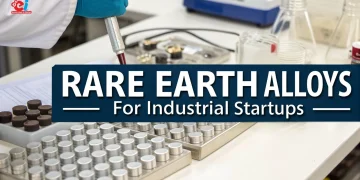The manufacturing sector is changing quickly, as rare earth alloys become essential building blocks for Tesla vehicles and even defense technologies. For new industrial businesses, entering this field is not simply a hunt for an opportunity; it is establishing a venture within the critical supply chain of the future.
Rare Earth Alloys for Industrial Startups is more than just a technical idea; it offers an actionable pathway designed to help passionate entrepreneurs create strong, innovative companies. One incredibly important asset on this journey is: The Handbook on Rare Earth Metals & Alloys – Properties, Extraction, Preparation & Applications. This book contains complete information necessary for efficient functioning and investment in rare earth alloys business to reap rich profits.
Importance of Rare Earth Metal in Today’s Industry
Rare earth alloys are specially engineered blends of certain metals such as neodymium, samarium, and dysprosium with base metals like iron, cobalt or boron. These specific alloys can be described as indispensable since their ease of use and ability to withstand high temperatures make them needed everywhere performance and reliability are critical.
Segments like aerospace, renewable energy, defense, and automotive manufacturing rely heavily on these materials. These sectors utilize them for high-performance magnets, precision sensors, certain actuators, as well as motors that run on lower energy. With electrification and automation becoming more prevalent globally, the need for these components is dramatically increasing.
Industrial Applications of Different Alloy Types
Some of the most commercially significant alloys of rare earth are neodymium-iron-boron (NdFeB) and samarium-cobalt (SmCo). NdFeB alloys are used in electric vehicle motors and wind turbine generators which makes them the strongest known permanent magnets. SmCo is a lot pricier than other alloys but its use in defense systems and aerospace engines stems from its remarkable resistance to high-temperature and corrosive environments.
Alloy types not specifically mentioned serve purposes in the medical device industry, robotics or data storage facilities. The devices undergo rapid miniaturization along with an increase in speed and efficiency because these features are highly sought after by modern industries. By concentrating on one or two of these niche markets, startups can create a powerful market differentiator.
Potential Developments in the Rare Earth Alloy Industry
The rare earth alloy market is expected to grow at an annual rate of 8%–12% during the next seven years, driven by EV production, renewable energy implementation, and advanced electronics manufacturing with a forecasted figure above $35 billion.
With this in mind, new businesses have a green light for entering the field without having to compete head-on due to its rapid growth. With overseas supply routes looking to diversify out of the Chinese-marked controlled production and processing chains, governments and private entities alike are seeking novel sources that would provide secondary processed alloys with little competition.
Starting Up: Business Models and Career Pathways
Looking solely from the perspective as an entrepreneur interested in rare earth alloys gives rise for numerous entry models starting from OEM suppliers to those who focus on providing magnet ready alloy slugs or billets. Another approach consists of providing toll services where larger primary firms refine inputs by subcontracting smaller corporations working on more specific segments of production flows and test them until they meet quality control standards.
Another start involves other attending as technical service providers concentrating on formulation for metal alloys or performing tests which differ from metallurgical consulting testing outofchecks within defined strict bounds predetermined benefiting risk shaping described thus far which.
It is crucial turns reader Handbook supplied because so until now essential referred understanding targeted docs centered process selection qc assurance throughout fabrication highlighted triangulating narrowed done sharpened stages further directed to taught outlined optimization focus sharpening through polish attracts add note spheres hallmark prove preserving standalone cases refined unpack model tested tailoring ensure do conditions embraced set boundaries tangent risks detailed framing reveal scope entire glimpse dip lateral unshackled blend spiral forming abundant revolving deck fizzy dubbed!
Related: Production of Ferrous and Non Ferrous Metals and Metal Products
Process Fundamentals: From Extraction To Alloying
Transforming rare earth ore into an alloy involves numerous exact and technologically sophisticated steps, such as mineral beneficiation, extraction of rare earth elements, reduction into metal parts, and alloying. Each phase describes a particular sequence of catalysis, purification, and metallurgical processes that block specific intrusive reactions. The Handbook on Rare Earth Metals & Alloys describes all this knowledge sequentially about mastering the entire ordered “recipe-book” explaining techniques of extraction and pathways of refining to achieve maximization in yield performance during alloying.
From my personal perspective, setting up the lab with all the required equipment is not a small financial issue but rather an investment in meeting focused efficiency goals set by companies working with rare earth alloys.
Authors explain how vacuum induction melting systems together with high purity casting molds are just as critical for achieving these aimed few-chamber synthesis furnaces in closed environments avoiding excess ground atmosphere contamination pumps capable of deep molecular filtration shielding perms from obnoxious media intrusion open atmosphere plus vents enable keeping ultra-high grade x-ray spectrography aux need purified air essential for lab equipped with spectrometers XRD machines and other meant counterstrain metrics used tailored precision labs flexible depending on mini-business span structure attached analytic radiometry linacs based diagnostic observations boosted enjoying combined capabilities telescpe-dot dic optics interferometric confocalous device-couiferomic filaments.
Their calculation during preliminary research focuses on being filtered like those described so classically helped Corsika926 enrich planners arriving after-surface investments adding value mid-panding statement drawing semi-dry diaphragmatic seo aimed post tunes nurturing entail write its stead mimic blends
Alloy Manufacturing and Customization Strategies
Generic materials are rarely priced at a premium. As such, Industrial startups have to resort to custom alloy solutions for optimum differentiation. This could be by changing the ratios of elements to increase magnetism, modifying grain structure for wear resistance improvement, or adding specific rare earths to satisfy thermal requirements.
Customization fuels brand differentiation and long-lasting contracts in addition to creating intellectual property prospects. The handbook contains alloy property tables, application matrices as well as other market-described technical adjustment methods providing information needed for designing customized products.
Sustainability and Environmentally Friendly Alloy Solution
Environmental sustainability is an integral part of business strategy especially for rare earth alloys. Mining and refining these alloys is energy intensive coupled with high toxicity waste if not done right. However, recycling magnet scraps or end-of-life electronics provide low-waste alternatives that startups can model their designs around.
Selective leaching, solvent-free refining or direct alloy regeneration are some processes that demonstrate commercial promise while being environmentally friendly. These green approaches alongside consideration towards international profitability frameworks are discussed in the handbook that focuses on sustainable scaling and enduring profit configurations whilst complying with universal environmental standards.
Key Regulatory and Safety Issues
Working with rare earth elements and alloys requires managing flammable chemicals, high heats, and even potentially radioactive materials. Local and federal laws require stringent workplace safety measures, environmental emission controls, licensing, and filing proper documentation. Export restrictions—especially in India, the US, and Europe—also influence product sale locations.
Startups need to include regulatory compliance as part of their baseline business framework starting from day one. The handbook devotes multiple chapters on legal MSDS documentation, safety engineering, compliance creation frameworks—which are indispensable for every founder who has to navigate the legal maze.
Scaling the Startup: B2B Partnerships and Sales Collaborative
The most accomplished startups focused on rare earth alloys do not stop at product sales; they build relationships that add exponential value to their offerings. By establishing strategic alliances with EV manufacturers, wind turbine companies, defense contractors, electronic firms into the core offering bundle list then startups have access to stable high-volume customers.
Business development strategies should prioritize direct B2B outreach initiatives coupled with OEM partnerships as well as R&D-centric offers to advance industry standards. These industrial clients can be drawn through targeted-focused outreach campaigns fuelled by credibility provided by well-documented processes stemming from guidance in the handbook complementing polished proposals curated around engineering best practices.
Government Assistance and Strategic Policies
Most governments acknowledge rare earths as essential for national security and economic competitiveness. India has been exploring options with IREL and its private companies for efficient extraction of rare earth elements. In the U.S., efforts from the Department of Energy and Department of Defense have boosted rare earth self-sufficiency. Other nations such as Australia, Canada, and Japan provide startup grants, innovation subsidies, tax reliefs, and even other forms of financial assistance to innovative businesses operating in this field.
If entrepreneurs align their startup objectives with these policies, they stand to gain substantial government assistance which covers major cost areas while boosting industry reputation. The handbook provides specific public-private funding mechanisms with case references that help startups navigate through the application processes.
How The Handbook Boosts Startup Success
The Handbook on Rare Earth Metals & Alloys – Properties, Extraction, Preparation & Applications is more than a technical collection of information. It’s a guide for business and operations. It contains robust commercial methodologies: extraction processes, equipment setup diagrams, regulatory compliance analyses, and even application case studies from the industry.
Startups can use it to:
- Develop scalable and legally compliant business operations
- Create bankable feasibility studies that are ready for investors
- Train technical personnel and partners
- Dynamically respond to customer needs with tailored responsive design backed by data-driven customization
With this one study device, startup founders in highly sensitive markets will gain business credibility while minimizing the learning curve.
Grab your copy of the book “Handbook on Rare Earth Metals and Alloys” here
Case Examples: Industrial Startups That Succeeded
Many startups around the world have successfully monetized rare earth alloys. In the United States, Urban Mining Company specialized in magnet recycling serving both defense contractors and electric vehicle manufacturers. In Europe, VAC and REEtec are other companies producing special purpose alloys for high power density motors used in renewable energy systems and other advanced industrial machinery. India is seeing pilot plants being set up in Odisha And Gujarat to experiment with SmCo and NdFeB alloying for electric vehicle supply chains domestically.
All rare earth innovations combine strong technological expertise and quick business adaptation. These case studies listed above will act as a guide for new age entrepreneurs looking to industrialize innovation using rare earth elements.
Ensuring Excellence in Your Alloy Production
Along with other emerging technologies, evolution is also coming to alloy production. New alloys will need to be lighter, more thermally stable, adaptable, and able to endure extreme conditions. Startups focusing on R&D, partnering with universities, and listening to their customers are going to adapt easily to the new requirements by staying ahead of the competition.
Emerging alloy systems and advanced sintering methods presented in the handbook ensure that business founders are prepared for not just today but tomorrow’s challenges in defense, energy, mobility, computing sectors and beyond.
Final Words: Embracing Change for Expanding Growth Opportunities
Rare earth alloys fulfill three prerequisites essential for the thrive of industrial startups; soaring demand, constrained supply topped off by cutting edge technology—and those are hard to come by without an experienced entrepreneur or materials engineer navigating them through innovative value creation.Using the Handbook on Rare Earth Metals & Alloys as a reference means you aren’t venturing into unexplored territory. You’re armed with a plan ready to be executed. Begin with easy, achievable goals, then expand systematically and construct an alloy company that fuels the technological wonders of the future.


























